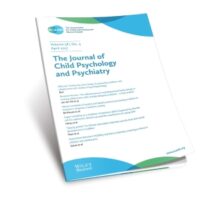Brain
-

Oxytocin Administration, Neural Sensitivity, and Autism
In this Papers Podcast, Dr. Matthijs Moerkerke discusses his JCPP paper ‘Can repeated intranasal oxytocin administration affect reduced neural sensitivity towards expressive faces in autism? A randomized controlled trial’. Matthijs is the first author of the paper.
Read more -

JCPP Editorial: Volume 64, Issue 10, October 2023
Editorial: “Paradigm ‘flipping’ to reinvigorate translational science: Outlining a neurodevelopmental science framework from a ‘neurodiversity’ perspective” by Edmund J. S. Sonuga-Barke
Read more -

Practitioner Review: Neurobiological consequences of childhood maltreatment – clinical and therapeutic implications for practitioners
Paper from the JCPP – ‘In this report, we explore key validated alterations in brain structure, function, and connectivity associated with exposure to childhood maltreatment as potential mechanisms behind their patients’ clinical presentations.’ Jacqueline A. Samson (pic) et al.
Read more -

Categorical versus Dimensional Structure of Autism
In this Papers Podcast, Dr. Tom Frazier discusses his JCPP Advances paper ‘Categorical versus dimensional structure of autism spectrum disorder: A multi-method investigation’. Tom is the first author of the paper.
Read more -

Report from a randomized control trial: improved alignment between circadian biology and sleep–wake behavior as a mechanism of depression symptom improvement in evening-type adolescents with depressive symptoms
Open Access paper from the JCPP – ‘These results provide novel evidence for improved alignment between circadian biology and sleep–wake behavior as a specific mechanism of depression improvement, provide key clues into the complex relationship between sleep and depression, and have significant clinical implications for adolescents with depression.’ Lauren D. Asarnow (pic) et al.
Read more -

Transdiagnostic Profiles of Behaviour and Communication: Academic and Socioemotional Functioning and Neural White Matter Organisation
In this Papers Podcast, Dr. Silvana Mareva discusses her JCPP paper ‘Transdiagnostic profiles of behaviour and communication relate to academic and socioemotional functioning and neural white matter organisation’. Silvana is the first author of the paper.
Read more -

More frequent naps are associated with lower cognitive development in a cohort of 8–38-month-old children, during the Covid-19 pandemic
Open Access paper from JCPP Advances – ‘Here we investigate sleep patterns in association with two measures of cognitive ability, vocabulary size, measured with the Oxford-Communicative Development Inventory and cognitive executive functions (EF), measured with the Early EF Questionnaire, in a cohort of 8–38-month-olds’. Teodora Gliga (pic) et al.
Read more -

‘Precious, like gold… everybody brings their gifts’ – Why changing culture and attitudes towards neurodiversity matters when supporting children and young people. (recording)
This webinar, organised by the ACAMH Scottish Branch, provided an opportunity to look at the changing culture and attitudes towards neurodiversity matters when supporting children and young people. The recordings are for delegates only.
Read more -

DNA methylation at birth and lateral ventricular volume in childhood: a neuroimaging epigenetics study
Open Access paper from the JCPP – ‘In this study, we conducted the first epigenome-wide association study of neonatal DNAm in cord blood with LVV in childhood (measured using T1-weighted brain scans at 10 years), based on data from a large population-based birth cohort, the Generation R Study (N = 840)’. Mannan Luo et al.
Read more -

Children with maltreatment exposure exhibit rumination-like spontaneous thought patterns: association with symptoms of depression, subcallosal cingulate cortex thickness, and cortisol levels
Open Access paper from the JCPP – ‘We studied the impact of maltreatment on self-generated thought (SGT) patterns and their association with depressive symptoms, subcallosal cingulate cortex (SCC) thickness, and cortisol levels in children.’ Ferdinand Hoffmann et al.
Read more